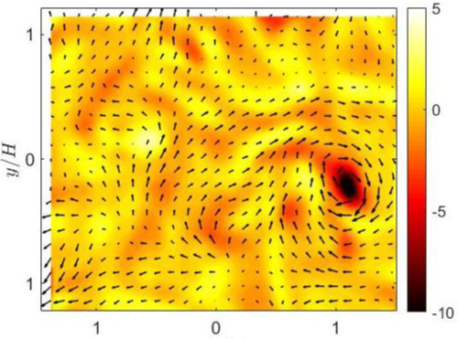
A Marie Skłodowska-Curie project.

Due to the need of an environmentally sustainable energy production, the generation of electricity from wind power is expanding worldwide, with Europe (182163 MW) being the second continent for installed capacity after Asia (261205 MW) in 2019 [1]. The optimal placement of wind turbines requires the knowledge of wind conditions at any place of a terrain. Predicting and characterizing wind turbines operating conditions demands detailed knowledge of atmospheric wind fields down to millimeter scales.
At ideal conditions turbulence is homogeneous and isotropic and is described by the Navier-Stokes equations. Its behaviour at small scales is supposed to be universal and to obey the Kolmogorov 1941 model [2]. Wind energy standards, like the International Electrotechnical Commission norms [3], are based on ideal turbulence, where turbulent fluctuations are considered random Gaussian fields. However, measurements show that atmospheric turbulence is not universal. Large wind fluctuations at small scales, also called wind gusts are extreme events responsible for the phenomenon of intermittency in atmospheric turbulence. Beside their spatial coherence, such events are characterized by large local amplitudes of the rate at which kinetic energy is dissipated in the turbulent fluid, a central quantity that cannot be predicted from the highly nonlinear and nonlocal mathematical equations of fluid motion. Intermittency is not considered by current flow models of atmospheric turbulence, even if it may have important consequences for wind turbines operating conditions. For example, Milan et al. [4] shows that the electrical power fed into the grid by a wind farm may change by 50% within two minutes because of wind gusts. As indicated by the European Academy of Wind Energy a fundamental study of the physics of wind power fluctuations is one of the eleven long term research challenges to advance wind energy science and knowledge [5].
Despite of the giant progress in the computational technique, it is still quite hard or sometimes even impossible to predict very complex flows like atmospheric flows, and therefore simplified model experiments are an exclusive way to study some of their fundamental properties. This project aims at understanding and predicting extreme events of energy dissipation from experiments in Rayleigh-Bénard convection (RBC), a turbulent fluid layer that is uniformly heated from below and cooled from above. RBC is a paradigm for atmospheric motions, as it combines turbulent momentum and heat transfer both of which being essential for geophysical flows.
Measurements of all terms of the energy dissipation rate in turbulent flows can be performed with multi-sensor hot wire probes, and with optical measurements. The former provides local time-resolved data with the disadvantage of having intrusive probes placed within the flow and of measuring in only one point of the domain. Optical measurements have the advantage of non-intrusiveness, and permit the visualization of the spatial structure of the energy dissipation rate that is not possible using point-wise measurement techniques. They require appropriately designed facilities with optical accesses for lasers and cameras, and advanced instrumentation to be performed. For this project, measurements of the energy dissipation rate are performed in the experimental SCALEX (Scaled Convective Airflow Laboratory EXperiment) facility at TU Ilmenau (TUIL) using Particle Image Velocimetry (PIV). This high-pressure facility allows several optical accesses and is ideal for PIV experiments (Figure 1).
Extreme events are statistically defined as fare tail events of the probability density function of a physical quantity. Due to their low probability of occurrence, they require long measurement or simulation time to be detected. Direct Numerical Simulations (DNS) are typically few hundreds large-scale convection (LSC) times long, while experiments can be a few thousands LSC times long. Experiments are necessary for the study of extreme events, because they allow to compute better statistics based on longer data acquisition times with respect to DNS.
Extreme events of energy dissipation in the bulk of RBC were studied numerically by Schumacher and Scheel [6]. They found in a closed convection cell that extreme events of thermal energy dissipation are due to nearly frontal collision of down and upwelling plumes. Such collision generates a high amplitude thermal dissipation layer, which is connected to a subsequent high energy dissipation event. Valori and Schumacher [7] found in DNS data that when plumes are generated at the same horizontal position in the opposite boundary layers simultaneously, the two plumes will most probably collide in the bulk of the cell provoking an extreme event of thermal dissipation. The collision develops a shear layer that is in turn responsible for an extreme event of energy dissipation, in agreement with the study of Schumacher and Scheel [6]. They observed that precursors of extreme events of energy dissipation in the bulk of the cell can be found in the boundary layers up to several free fall times in advance.
Machine Learning (ML) methods are an efficient and unbiased way to process a large amount of data effectively. ML has been rarely applied to the detection of extreme events in fluid turbulence. In this project, supervised ML will be used to uncover the complex non-linear relationships between the plume formation at the horizontal walls, and the manifestation of extreme events of energy dissipation in the bulk of RBC. By using Recurrent Neural Networks (RNNs), a large amount of data (time series of experimental and simulation data) will be processed to construct a model. This model will have as only input the temperature measurements at the walls of the RBC cell. The predicted extreme events are large wind fluctuations at small scales, wind gusts, which may have important consequences for wind turbines operating conditions.
A recurrent neural network in the form of a reservoir computing model (RCM) was applied to reproduce highly intermittent experimental data from stereoscopic PIV measurements [8,9]. This work regarded the detailed analysis of the intermittent statistics of velocity derivatives in the bulk of a turbulent RBC flow in pressurized air with stereoscopic PIV measurement. These data were obtained by placing the cameras under pressure inside the SCALEX facility. The results agree with the numerical study on the intermittent non-Gaussian small-scale statistics in RBC [3].
These experiments were used as inputs in a RCM that can reconstruct the dynamical evolution and statistics of the small-scale velocity derivatives including the prediction of extreme high-amplitude events (see Figure 2, Figure 3, and Figure 4).



[1] Wind Energy International, https://library.wwindea.org/global-statistics/
[2] U. Frisch, Turbulence: the legacy of AN Kolmogorov, Cambridge University Press, 1995
[3] IEC 61400-1, Wind turbines. Part 1: Design requirements, International Electrotechnical Commission, 2005, 3rd ed.
[4] P. Milan, M. Wächter, and J. Peinke, Turbulent Character of Wind Energy, Physical Review Letters, 2013. DOI: https://doi.org/10.1103/PhysRevLett.110.138701
[5] G. A. M. van Kuik et al., Long-term research challenges in wind energy – a research agenda by the European Academy of Wind Energy, Wind energy Science, 2016. DOI: https://doi.org/10.5194/wes-1-1-2016
[6] J. Schumacher, J.D. Scheel, Extreme dissipation event due to plume collision in a turbulent convection cell, Physical Review E, 2016. DOI: https://doi.org/10.1103/PhysRevE.94.043104
[7] V. Valori, J. Schumacher, Connecting boundary layer dynamics with extreme bulk dissipation events in Rayleigh-Bénard flow, Europhysics Letters, 2021. DOI: https://doi.org/10.1209/0295-5075/134/34004
[8] V. Valori, A. Thieme, C. Cierpka, J. Schumacher, Rayleigh-Bénard convection in air: out-of-plane vorticity from stereoscopic PIV measurements, 14th International Symposium on Particle Image Velocimetry, 2021. DOI: https://doi.org/10.18409/ispiv.v1i1.44
[9] V. Valori, R. Kräuter, J. Schumacher, “Extreme vorticity events in turbulent Rayleigh-Bénard convection from stereoscopic PIV measurements and reservoir computing “, submitted to Physical Review Research, 2021. DOI: https://arxiv.org/abs/2112.05442
Dr. Valentina Valori
Technische Universität Ilmenau
Department of Mechanical Engineering
Fluid Mechanics Group
e-mail: valentina.valori@tu-ilmenau.de